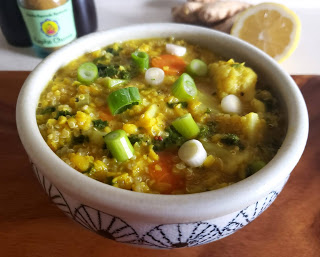
Kapha Kitchari
Published Date: 4/13/2021 9:55:44 AM
"Kapha" pacifying
YIELD: 4 servings PREP: 10 minutes COOK: 20 to 30 minutes
This extremely nourishing meal can be eaten for breakfast, lunch, and dinner. It is ideal for a mono-fast during a cleanse. In Kapha kitchari, we use less ghee than for the other two doshas, but it is still an important ingredient for a satisfying meal, as the ghee deposits nutrients deep down into all seven layers of your tissues. A little bit of ghee goes a long way!
"Kapha" can also speed up the cooking process by preparing over higher heat. Just stay present and stir more frequently. The fast cooking time may translate into helping Kapha speed up a bit!
- ½ cup dried split yellow mung beans (dal)
- ½ cup dried white basmati rice or ½ cup uncooked quinoa
- 2 cups chopped vegetables and/or leafy greens (two or three types, see choices on next page)
- 3 carrots, chopped
- 2 celery stalks, chopped
- 1 teaspoon ghee
- 1 teaspoon black mustard seeds
- ½ teaspoon cumin seeds
- ½ teaspoon ground coriander
- ½ teaspoon ajwain seeds
- ½ teaspoon ground cinnamon
- ½ teaspoon ground cloves, or 2 to 3 whole clove buds
- 1 pinch hing
- 1 teaspoon turmeric powder
- 1 to 2 cloves garlic, chopped
- 1 (2-inch) piece fresh ginger, peeled and grated or minced
- 1 small yellow onion, chopped
- 4 to 6 cups water
- 1 to 2 teaspoons Himalayan salt
- 1 teaspoon pepper
- 1 teaspoon Bragg’s Liquid Aminos (optional)
- 1 small handful chopped fresh cilantro (for garnish)
- Place the beans and rice or quinoa in a bowl of water, and rinse until the water runs relatively clear. Fill the bowl with water, and allow the beans and rice or quinoa to soak while you prepare the recipe, for up to an hour.
- Wash and chop the vegetables, carrots, and celery.
- Before starting the vagar (oil-spice mixture), turn on the exhaust fan over the stove, as spices can give off a strong aroma. Then in a 6-quart soup pot over medium-high heat, heat the ghee. Add the black mustard seeds. When they pop, add the cumin, coriander, ajwain, cinnamon, cloves, hing, and turmeric. Cook for about 1 minute, or until aromatic. Spices burn quickly; do not allow them to smoke.
- Stir in the garlic, ginger, and onion.
- Drain the rice or quinoa and beans, and add them to the vagar. Stir until the rice or quinoa and beans are coated. Allow sitting for 1 to 2 minutes, stirring occasionally.
- Add the water to the pot, and stir. Add the vegetables, carrots, and celery, and stir again. Cover the pot, and bring to a boil over medium-high heat. (If using leafy greens, add them in step 7.)
- Lower the heat to a simmer. Simmer until the water is absorbed, about 15 minutes, or until the kitchari is the consistency you desire. Just before removing the pot from the heat, add the greens and stir until wilted.
- Add the salt and pepper toward the end of cooking.
- Remove from the heat. Divide into four portions. If using, add Bragg’s Liquid Aminos to the portion you will eat right away. Garnish the single portion with cilantro, if desired.
- Use less water for a stew-like consistency or more water for a soupier consistency. It is important to use Himalayan salt in this recipe; sea salt will add more water to already watery Kapha, which is undesired.
- Ideal vegetable choices for this dish include burdock root, cauliflower, broccoli, white potato, daikon radish, green beans, spinach, kale, mustard greens, and chard. To reheat uneaten portions, add some water to the pot and heat over medium heat. Never microwave or freeze.